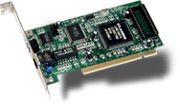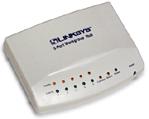Cables
The two most
popular types of network cabling are twisted-pair (also known as
10BaseT) and thin coax (also known as 10Base2). 10BaseT cabling
looks like ordinary telephone wire, except that it has 8 wires
inside instead of 4. Thin coax looks like the copper coaxial
cabling that's often used to connect a VCR to a TV
set.
We recommend that 10baseT or Cat5
cables for most home or small business networks. It is thin,
easy to manipulate and comes in custom lengths easy to
purchase. The 10baseT/Cat5 cables have connectors that
resemble a phone cord connector, only larger. These are
called RJ-45 connectors.
Which type of cabling is best
for you?
Thin coax and 10BaseT can
both be used exclusively or together, depending on the type of
network that you're putting together. Small networks, for example,
may want to use 10BaseT cabling by itself, because it's
inexpensive, flexible, and ideal for going short distances.
This is recommended for home networks as it is the
easiest.
Larger networks (usually with 10 or
more computers) may use a thin coax backbone with small clusters
of 10BaseT cabling that branch off from it at regular
intervals.

Network Adapter
Card
A network computer is
connected to the network cabling with a network interface card,
(also called a "NIC", "nick", or network adapter). Some NICs are
installed inside of a computer: the PC is opened up and a network
card is plugged directly into one of the computer's internal
expansion slots. 286, 386, and many 486 computers have 16-bit
slots, so a 16-bit NIC is needed. Faster computers, like
high-speed 486s, Pentiums, PentiumII and PentiumIII, all
have 32-bit, or PCI slots. These PCs require 32-bit NICs to
achieve the fastest networking speeds possible for speed-critical
applications like desktop video, multimedia, publishing, and
databases. And if a computer is going to be used with a Fast
Ethernet network, it will need a network adapter that supports
100Mbps data speeds as well. These cards are often referred
to as 10/100cards.
If a PC lacks expansion slots (which is true
with portable PCs), special network adapters are used. A PCMCIA
network adapter connects a PC to a network if the PC has a credit
card-sized PCMCIA expansion slot, while a pocket adapter connects
a PC to a network through the its printer port.

HUB
The central
connecting device is called a hub. A hub is a box that is used to
gather groups of PCs together at a central location with 10BaseT
cabling. If you're networking a small group of computers together,
you may be able to get by with a hub, some 10BaseT cables, and a
handful of network adapters. Larger networks often use a thin coax
"backbone" that connects a row of 10BaseT hubs together. Each hub,
in turn, may connect a handful of computer together using 10BaseT
cabling, which allows you to build networks of tens, hundreds, or
thousands of computers.
Like network cards, hubs are available in both
standard (10Mbps) and Fast Ethernet (100Mbps)
versions.

SWITCHING
HUB
The Switching hub, sometimes
called a "Switch" is a more advanced unit over the basic
hub. In a basic hub, all the computers connect to it and the
speed of the network is defined by the slowest computer network
card connected. If you have 10 100Mbps cards on the network
and just on 10Mbps card, the system cannot run faster than that
one 10Mbps card. There in comes the Switching hub.
This hub treats each network card independently and in the matter
of the 10 100Mbps network with the one 10Mbps network card, the
Switching hub allows all of the faster connections to remain at
the higher speed and still interact with the 10Mbps
system.





